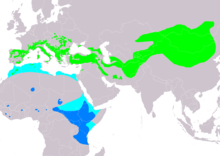Common rock thrush
| Common rock thrush | |
|---|---|

| |
| male, Spain | |
| Scientific classification | |
| Domain: | Eukaryota |
| Kingdom: | Animalia |
| Phylum: | Chordata |
| Class: | Aves |
| Order: | Passeriformes |
| Family: | Muscicapidae |
| Genus: | Monticola |
| Species: | M. saxatilis
|
| Binomial name | |
| Monticola saxatilis (Linnaeus, 1766)
| |

| |
| Range of M. saxatilis Breeding Passage Non-breeding
| |
| Synonyms | |
|
Turdus saxatilis Linnaeus, 1766 | |
The common rock thrush (Monticola saxatilis),[2] also known as rufous-tailed rock thrush or simply rock thrush, is a chat belonging to the family Muscicapidae. It was formerly placed in the family Turdidae. The scientific name is from Latin. Monticola is from mons, montis "mountain", and colere, "to dwell", and saxatilis means "rock-frequenting", from saxum, "stone" .[3]
It breeds in southern Europe across Central Asia to northern China. This species is strongly migratory, all populations wintering in Africa south of the Sahara. It is an uncommon visitor to northern Europe. Its range has contracted somewhat at the periphery in recent decades due to habitat destruction. For example, in the early 20th century it bred in the Jura Krakowsko-Częstochowska (Poland) where none occur today,[4] but it is not considered globally endangered.[1]
Description
[edit]This is a medium-sized but stocky thrush 17–20 cm in length. The summer male is unmistakable, with a blue-grey head, orange underparts and outer tail feathers, dark brown wings and white back. Females and immatures are much less striking, with dark brown scaly upperparts, and paler brown scaly underparts. The outer tail feathers are reddish, like the male.[5]
Behaviour and ecology
[edit]This species breeds in open dry hilly areas, usually above 1500 m. It nests in rock cavities, laying 4–5 eggs. It is omnivorous, eating a wide range of insects, berries and small reptiles. The male common rock thrush has a clear and tuneful song.[5]
Gallery
[edit]-
Common rock thrush, Boulmane de Dades, Morocco
-
Eggs, Collection Museum Wiesbaden
References
[edit]- ^ a b BirdLife International (2017). "Monticola saxatilis". IUCN Red List of Threatened Species. 2017: e.T22708257A111788908. doi:10.2305/IUCN.UK.2017-1.RLTS.T22708257A111788908.en. Retrieved 12 November 2021.
- ^ English Name Updates - IOC Version 2.9 (July 10, 2011) Archived March 3, 2012, at the Wayback Machine, IOC World Bird List
- ^ Jobling, James A. (2010). The Helm Dictionary of Scientific Bird Names. London, United Kingdom: Christopher Helm. pp. 260, 348. ISBN 978-1-4081-2501-4..
- ^ Tomek, Teresa & Bocheński, Zygmunt (2005): "Weichselian and Holocene bird remains from Komarowa Cave, Central Poland". Acta zoologica cracoviensia 48A(1-2): 43-65.
- ^ a b Clement, Peter & Hathaway, Ren (2000): Thrushes. Christopher Helm, London. ISBN 0-7136-3940-7
External links
[edit] Media related to Monticola saxatilis at Wikimedia Commons
Media related to Monticola saxatilis at Wikimedia Commons- Oiseaux Photos, map, text.(in French)
- Ageing and sexing (PDF; 1.2 MB) by Javier Blasco-Zumeta & Gerd-Michael Heinze
- Handbook of the Birds of the World
- BirdGuides
- Macaulay Library
- Mangoverde; direct link here
Lua error in Module:Navbox at line 192: attempt to concatenate field 'argHash' (a nil value).



